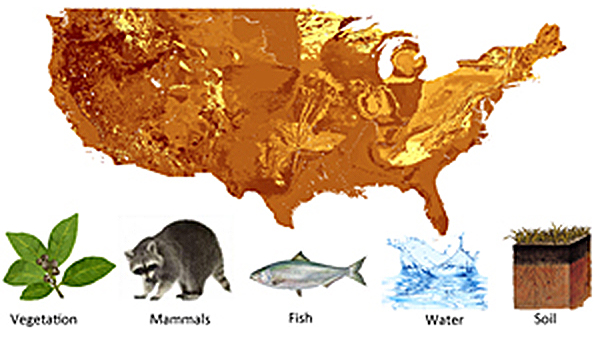
University of Cincinnati scientists are reporting a significant finding that could open up entirely new explorations in the fields of ecology and paleoecology. A mathematical analytical tool that was designed to predict a common elemental signal in surface water — resulting in significant savings compared with traditional field surveys — also is effective at predicting values for a wide range of materials, and is in fact most successful when applied to the bones and teeth of mammals. The research by Brooke Crowley and Joshua Miller, assistant professors of geology at UC, and Clément Bataille, an earth scientist at the Chevron Corporation, is published online for an upcoming issue of the research journal, Biological Reviews.
Strontium ratios in rocks vary depending on the type of rock and the rock’s age. The continental-scale water model previously developed by Bataille and Gabriel J. Bowen, an associate professor of geology and geophysics at the University of Utah, uses U.S. bedrock geology and all major river systems and drainages to predict strontium isotope ratios (the ratio of strontium 87 to strontium 86) in surface waters.
The research, led by the University of Cincinnati, used the water model to compare predicted strontium isotope ratios in surface water, soil, vegetation, fish and mammal skeletal tissues from a massive collection of data led by Crowley across the U.S., excluding Alaska and Hawaii.
“Because the ratio of strontium 87 to strontium 86 in water, soil, vegetation and animal tissues predominantly reflect local geology, they can be used to distinguish geologically distinct regions as well as identify highly mobile populations,” says Crowley. “We tested how accurate the model was at predicting strontium ratios not just in water, but in additional materials relevant to ecological and paleoecological research.”
The tool worked for all materials but appeared to be most successful in predicting strontium ratios in mammals. “There’s every indication that mammals are better predicted using this model than other materials,” says Miller.
“We think the model’s success at predicting strontium ratios for mammals is related to how the landscape is sampled by this analytical tool,” adds Crowley. “The predictions for the larger mammals were better than the smaller mammals. This is likely because the amount of area covered by a larger mammal more closely resembles the space that the model understands.”
Tracking strontium isotope ratios is a valuable tool beyond the science at top research institutions like UC. Strontium is a heavy earth metal that can be found in most organic substances such as bones, teeth, soils and plant tissues. As a result, strontium isotope ratios are used in fields including forensics research, animal poaching investigations, and even tracking where marijuana plants came from in drug busts.
Although strontium isotope analysis related to biological research is on the rise, the expense in terms of ground mapping has been prohibitive.
“It’s a really powerful system, but in order to get an idea of where elephant tusks confiscated in Kenya came from, for example, investigators would have to track the strontium signals throughout the country or potentially all over East Africa,” explains Miller. “Models like the one we tested could make it possible to quickly get a good idea of where that animal was originally from.”
The researchers say the water model provides a readily available source of background data for predicting strontium ratios for biologically relevant materials in regions where empirical data are lacking. “The availability of increasingly high-quality modeled strontium data will dramatically expand the accessibility of this geochemical tool to ecological applications,” says Crowley.
Reference:
Brooke E. Crowley, Joshua H. Miller, Clément P. Bataille. Strontium isotopes (87Sr/86Sr) in terrestrial ecological and palaeoecological research: empirical efforts and recent advances in continental-scale models. Biological Reviews, 2015; DOI: 10.1111/brv.12217
Note: The above post is reprinted from materials provided by University of Cincinnati. The original item was written by Dawn Fuller.










